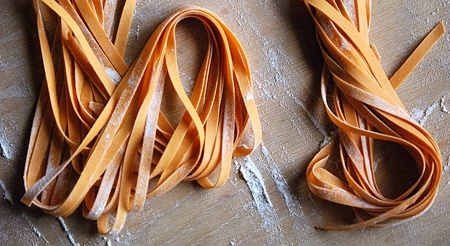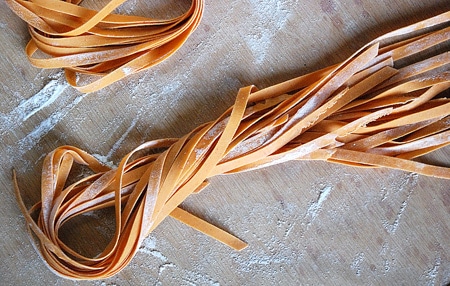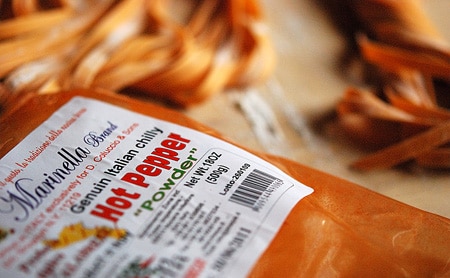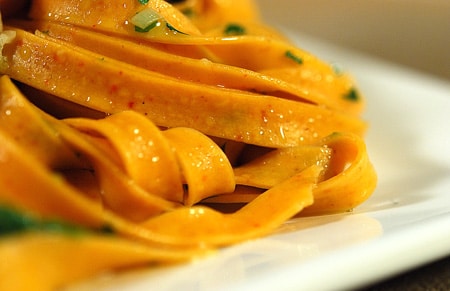As an Amazon Associate I earn from qualifying purchases.

I make pasta at home a lot, have been for years. It is a soothing process I find utterly absorbing: knead, roll, cut, fill, shape. Even after several hundred batches, homemade pasta still satisfies something elemental within me.
At its core, all pasta is flour and water. But its sum outshines the parts. When I look at row after row of freshly made pasta, I feel like I’ve done the impossible, that I’ve made something out of nothing. It feels like alchemy. And it is.
Over the years, as I have grown more skilled, pasta-making has become a larger journey that I see no end to — with endless combinations of flours and ingredients, both within the pasta and as sauce, as well as endless shapes, sizes and widths, each lending a distinct character to the finished product.
I make no pretense of being the best pasta-maker in the world. There are pasta skills that remain out of my reach, like rolling dough so gossamer thin you can read through it, armed with nothing more than a rolling pin and a hardwood board. But knowing that thousands of nonnas and zias and even Anglo cooks like me have mastered this seemingly magic ability keeps me going, like a martial artist training to reach a higher degree of enlightenment — and lethality.
That said, I’ve gone, trial-and-error style, through so many batches I think I finally have a few tips to offer on how to make first-rate homemade pasta.
I used to think one kind of pasta was pretty much the same as another. When I was in college, my girlfriend DeDee would always squinch up her nose when I cooked spaghetti; she only liked vermicelli with her tomato sauce. I rolled my eyes at her. “What’s the difference?” She couldn’t quite explain it, but stood firm. There was a difference to her.
DeDee was right. Vermicelli is thinner than spaghetti, more delicate. If you pay attention, you get a lighter mouthfeel eating a bowl of vermicelli (also known as spaghettini) than you do with the heftier spaghetti. I realized this fact sometime in my 20s.
At about the same time I discovered that ziti with ridges held sauce better and were also lighter than smooth ziti. And penne, which are ziti cut on an angle, catch sauce better than ziti, which are more suited to being baked in a casserole; the pointy end of the “pen” in penne funnels sauce the way the straight-cut end of ziti cannot.

Consider the long, flat noodle for a moment. At first glance, they all look roughly the same. Somewhere between eight inches long and two feet, they are all between a quarter inch and 5/8 of an inch thick, and pretty much the same width, right? Nope. Linguine is a thick pasta, while tagliatelle, which is similarly wide, is far thinner. Pappardelle is just as thin as tagliatelle, but twice as thick, sometimes more than 1/2 inch wide. They all feel different when you eat them.
You can see why Italians get real persnickety about which sauce goes with which noodle. For the record, thin pasta like spaghetti needs a smooth sauce. Thick pappardelle is normally served with chunky wild game sauces.
All this is just a primer on why the Italians developed several hundred pasta shapes. Every day I am learning about new ones, thanks to an amazing book — fittingly called the Encyclopedia of Pasta — that goes into the details of all these shapes. But what about the ingredients in the pasta itself?
Start with flour. I used to think all fresh pasta was made with “regular” flour, as in all-purpose. Wrong. Many of the most delicate pastas are made with something called “oo” flour, which is ground finer than all-purpose. Then there is semolina, another variety of wheat that is harder than common flour; it’s used in fresh pasta made in Southern Italy. Again, the fineness of the grind matters enormously, which is why buying Italian semolina matters.
I am now getting my standard flours imported from Italy, courtesy of Scott Stegen, who runs the blog Sausage Debauchery. Scott works for an importer who has allowed him to set up an online store; you can see links to his eBay store in various places around this site. I can vouch for his stuff — it’s the real deal, down to the Calabrian red pepper powder for the spicy salami nduja that is so in demand now.

I used some of that red pepper powder to make an unusual pasta. I’d dimly been aware that Italians will sometimes put chiles in their pasta dough — although “adulterating” dough is controversial in Italy, depending on which region you’re talking about. Some scoff even at the use of chopped, cooked spinach to make that very traditional green pasta. But I’d since seen recipes for hot pepper pasta both in the south of Italy (Calabria, Puglia and the like), as well as in Tuscany. My recipe for the spicy pasta is an amalgam of both Calabrian and Tuscan recipes.
Different flours make huge differences. Scott’s “oo” flour is far smoother than even the King Arthur all-purpose I’d been using. I’m looking forward to using to make some delicate, egg-heavy pastas down the road.
Using grains other than wheat creates even flashier effects. You will see a lot of alternate-grain pastas on this site because I cook so much wild game. Adding rye, barley and spelt to pasta gives it a more rustic feel. Scott is trying to find me something called grano arso, which is flour from toasted — almost burnt — wheat. It was historically something only the poorest of the poor used, but it is now used by artisanal pasta-makers as a way to reconnect with the past. Can’t wait to experiment with it!
I kick up the rustic factor even further by adding more “adulterants” to the pasta dough — typically chestnut flour, chickpea flour and more recently, acorn flour. All add a lot to the pasta’s flavor, but make the dough more difficult to bring together because none of these flours has any gluten; I combine them with higher-gluten bread flour when I make these pastas.
The Final Frontier with flours will be grinding my own. I do not yet have a flour mill, but I reckon it is only a matter of time. Flour is incredibly stable, but it will go stale over time; this is why many flours (rye and barley in particular) are best stored in the fridge. Ever smell fresh-ground flour? It is every bit as intoxicating as fresh-ground coffee.
Yet even if you stick with regular old flour and make regular old pasta, there is still nuance in the making of it.
How much liquid? Eggs or no? And if so, how many, and will you use whole eggs or just the yolks or whites? There is a decadent pasta called tajarin from Piemonte in Northern Italy that has so many egg yolks in it they designed another pasta with just the whites called “sheets and linens.”
Will you add oil? What about salt? I add salt almost always, but just a pinch. Why? Because fresh pasta cooks so fast it barely has time to absorb salt from the water. Olive oil will find its way into my pastas, but usually because I coat the kneaded dough with it before letting it rest for an hour — and I never make pasta without letting it rest at least an hour. This is important for hydrating the flour, as it takes time for it to absorb the liquid. Long resting times are absolutely vital with flours like acorn, chickpea and chestnut. I will often rest pasta with these flours for half a day.

When do you want a “wet” dough and when do you want a dry one? Some doughs are so dry they are very difficult to knead, while others are so sticky they are tough to keep from attaching themselves to your board.
I use wet doughs with filled pasta like ravioli because I want the pasta supple during the relatively long time it takes me to fill them. I use dry doughs with long-cut noodles like tagliatelle and spaghetti. If I had a pasta extruder (another thing on my to-do list) a dry dough would be more appropriate there, too. Generally speaking, you want pasta dough to be cool and soft and smooth — I always think of the way the inside of a woman’s forearm feels to judge whether my dough “feels right.”
I roll my pasta with a manual pasta machine; an Atlas, to be exact. I have never tested other brands, but my Atlas has served me well for a decade. I have used mechanized pasta machines, however, and I don’t like them. You cannot stop and start the machines easily, and I often stop to adjust things midway — this is exceedingly important with very thin pastas, or when your dough is wet, so you can keep everything from sticking.
As for gadgets, they have their uses. I’ve used ravioli rolling pins and they’re cool, but I generally cut mine by hand or use a stamp. I also have a chitarra, which is a box with wires stretched on it like a guitar. It creates tagliatelle-like pasta by laying a sheet of pasta on the wires and then rolling the pasta through with a rolling pin.
I could go on and on. And I will, later. Pastas are such a natural accompaniment to the kind of cooking I do that I plan on writing more about them as I go. To that end, I have created a special page with all my pasta recipes, where there are both recipes for pasta-making itself as well as pasta sauces for either homemade or store-bought pasta. Some recipes are simple, others baroque.
One reason I put all this out there is because I know there are a lot of very good cooks who read this space, many of whom make their own pasta. Care to spill your secrets? What gadgets do you use? Any pointers on a flour mill? Has anyone mastered rolling pasta with just a pin?

____________




Van: It’s just olive oil, parsley, lemon zest and garlic.
Excuse me, what is the name of the sauce?
Please let me know when you find some “Grana Arsa” or burnt flour. I can not find a source for it anywhere in the states. Thank you sooo much.
Can you recommend any other books besides The Encyclopedia of Pasta for basic dough recipe variations? We’ve ordered it and I’m excited to read it, but it looks extremely academic. My boyfriend picked up Stir by Barbara Lynch. She goes on at great length about her love of fresh handmade pasta, and then half the recipes in the book call for random dried. The only variations listed are gnocchi. We have Vegetarian Bittman and also enjoyed his Best Recipes in The World there are few recipes in each, but very basic. Looking for a jewel of a book in order to play!
Hey Angela: I always do filled pasta set on No. 8, which is the second-to-last setting on my machine. It works fine, but I knead my dough a long time, let it rest at least 2 hours, and then flour the hell out of it when I am rolling it thin. I never have a problem with pasta falling apart in the water, although when you get really thin it can tear easily when you handle it.
Hi Hank!
I just happened across your website the other day looking for a red pepper pasta recipe to accompany some spinach pasta I made, thinking they would look pretty together dressed in some butter and lemon and herbs from my garden, and then I got lost in your recipes for a while, they look so lovely! I have a quick question for you if you care to help an advanced beginner 🙂 I use just a small hand crank Atlas 150 (I too love the feel of the smooth cool fresh sheets rolling out, beautiful!) and I always seem to chicken out and make the sheets destined for filling too thick. I made some ravioli tonight and though they were tasty the skirt was just a bit too heavy and chewy. I used the number 6 setting of 9 thickness settings. What do you use? I made fettuccine once with number 8 and it was much too delicate and sort of fell apart in the water, and since then I stick to number 5 or 6 usually, not wanting to ruin an hour + of work again. Help?
Great topic, if I can offer a simple tip for beginners: buy a good pasta roller/cutter and start! its fun, even when it isn’t perfect. Great pasta is a little like the old joke about “How do you get to Carnegie Hall?”
Practice, practice, practice.
Sean: That’s exactly the feeling I am talking about!
I like to make pasta to unwind! Soothing process and fun too!
Mmm … I love the sensation of the cool sheets of pasta draping over my hands as they go through the kneader. Everytime I make pasta, I have an urge to make something non-edible out of it — sculpture, or masks or something. But, in the end, I just eat it.
Kristopher: I’m on it! I like the smoked meats, toasted pasta combo.
Dawn: Those tagliatelle (almost pappardelle, actually) look thick and hearty — good choice of sauces with that one. Nice work with just a rolling pin!
I just started making homemade pasta a month or so ago, and now I crave it all the time. I don’t have a pasta machine (yet), so I have no choice but to roll mine out by hand. It’s time consuming, but it is also a very satisfying, soothing endeavor. I cut mine by hand, too, so as a result all my pastas have been fettucini width or wider, with a few raviolis thrown in for good measure. I’m working on a pasta post, but here’s a sneak peak. How’d I do? https://www.flickr.com/photos/dawn_kitchentravels/4317668836/in/set-72157622726804637/
I make ndjua that i smoke for 2 hours a day for 5 days. a little ndjua, a little heavy cream, over chitarra pasta made with grano arso. italian flat parsley and grana garnish. the toasted flour and smoked meat are nice. also a mushroom ragu with cream and pici pasta is nice. parm garnish. (you can use the widest setting on a chitarra to cut the pici then hand roll to finish)
Tamar: Skin on a rice pudding… Very vivid image in my head. I suppose I will get there, too. Sucks to get old.
Kristopher: D’oh! But of course I can toast my own! How could I not have thought of that. Now I feel silly. You mention “several sauces” go well with grano arso. Which ones?
Hank, you can toast your own flour in a hot oven on a sheet pan. That way you control the amount of toast. It works well and adds a dimension of flavor that is complimentary to several sauces.
I ran the pepper through my spice grinder before so yeah i guess pretty finely ground although i didn’t think it would be an issue. Beginner’s luck perhaps?
What beautiful pasta! Where are all the ragged edges and broken pieces I always get? I’m going to try a longer rest and see how I do.
About the woman’s forearm tip, though. I can attest that, after a certain age, a forearm can be more like the skin on the rice pudding than the firm fresh pasta. I’ll be aiming for what my forearm used to feel like.
Don’t feel too bad, I do NOT like sticky dough. The bread machine does not eliminate all of the kneading. I just don’t wanna get my fingers all gooey and
the little paddle takes care of it. I still have to knead the dough some before it rests. Then I use an Atlas like everybody else…
Adele: That is a great tip! I also find my whole egg pasta becoming brittle when I freeze it. Wonder what about the egg white that does that. As for “sheets and linens,” just add 2 whites per cup of flour and start from there. You might need more, maybe less. But that’s where I would begin…
John: Been thinking about chocolate pastas — Michael Symon made a traditional one on Iron Chef last weekend. There is an Italian chocolate pasta served with a savory sauce, too…
Will: Another good tip – I am in need of cleaning my Atlas, and that should do the trick. VERY sorry to hear about your gluten-less life. I suppose love is stronger than bread and pasta, but I hope I never need to make that choice.
Mark: You can bet I will report back. I know Michael Ruhlman a little, and he is as big an evangelist for French cuisine as I am of Italian and Greek. Hope his book translates for those cuisines…
Peter: Nice to hear from you again! Beet juice is actually *very* traditional in Italy — again, depending on where you are. But what is hijiki?
Scott: Thanks for chiming in, and I await the new storefront! I had forgotten about buckwheat flour pasta, which they make in the far north. It is of course a lot like Japanese soba.
Hi all. Please excuse the ebay storefront as my website is under construction. Also know, I am looking for buckwheat flour to make pizzocheri. I think I’m close. Keep checking back. Thanks.